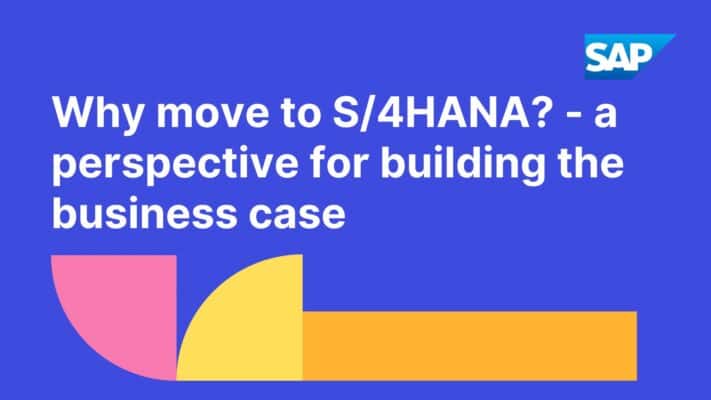
Feb 22, 2024
by Ajit Pokharkar
IT Manager - ERP & Enterprise Systems
Ajit is an IT Manager experienced in delivering and managing Enterprise IT systems & Projects in the Consumer Goods & Manufacturing industry. Key functional delivery areas include Sales & Supply Chain execution systems; focal points being SAP ERP & S/4HANA.
How do we justify high costs of an S/4HANA migration? What is the value proposition of S4 for my business? How do I explain to my executives the benefits of S4?
SAP customers are grappled with questions similar to these while building business case.
I think taking an outside-in approach to build a story contextualized for your own business will work best. So here is a perspective or let me say this is how I will do it. And am hopeful this may provide some levers to weave your narrative.
Couple of quick notes – This piece of write-up will be purposely non-technical. It is also not meant to prescribe a business case format but is rather meant to provide pointers that one can ingest in their business case, if found useful.
Let us walk through below depiction split in 3 parts – A & B are really the bits showing ‘Why’ S4 should be an option for your business. C is to make the cost justification for the ‘Why’.

a. Make a ‘Legacy Migration’ argument
“It is not the strongest of the species that survive, nor the most intelligent, but the one most responsive to change.” – Charles Darwin.
Above is equally true for organizations. So when your ERP software starts becoming a legacy it only makes sense to start considering replacement or migration.
One may ask why to start with such a simplistic view of legacy migration and not some flashy point of view centered around innovation or strategic digital transformation etc. Well, starting simple makes a lot of sense most times. This kind of argument also helps dilute initial exec resistance as legacy replacement is harder to argue against compared with ‘digital transformation’ narrative without clear tangible benefits upfront.
Additionally also consider this – I equate the ERP system to be heart of a modern day enterprise – quite analogous to how engine will be to a car. So when automobile manufacturer stops producing the car you have as they upgrade the engine platform, you would consider upgrading the car. If not, you live with a sub-optimal engine leading to inefficient performance.
While it can be difficult to make easy justifications for expensive initiative like S/4HANA, below pointers can aid to set the tone.
- SAP’s ERP evolution – a historical precedent
Research indicates 7 to 10 years as a useful life of a ERP software. Let us look at some historical facts. SAP invented ERP in 1979 with R/2. 1992 was the year when R/3 was launched. ECC6 made its way around 2004-05 and finally S/4HANA was launched in 2015. This history goes on to show reinvention of the flagship ERP product from legacy every 10-12 years & S4/HANA is simply following that historical precedent.
So. we are not presented with some fancy new ERP product out of turn from usual product life-cycle.
- Value potential of ERP modernization & solid foundation for future
S4 is a byproduct of the generational shift we have seen on account of tech revolution. Remember, your current version of ERP (most likely ECC6) came around when AWS & Azure were still to be launched, Costs of memory & high network speeds were still huge, and smartphone revolution was still to begin – 1st generation iPhone was launched in 2007.
So when a modernized ERP is invented, one would move to it to keep up the pace with technological change, stay contemporary & do what competitors are doing at large. Therefore, S4 has to be thought of as a strategic investment for solid future foundation with benefits delivered over multi-year period. And this makes it hard to quantify all the business benefits in the beginning.
Having said that, intangible value potential should still be articulated. Few Examples include
- Improved employee engagement due to modernized Fiori based UX
- Increased employee productivity as a result of runtime reduction of ERP reports on HANA database
- BTP strengthening the future foundation by opening up opportunities for modern custom application developments on simplified integration architecture
Value justification of these kind of examples is no different from value of renovating a house or value of upgrading from iPhone 10 to iPhone 14. The argument essentially is – ‘you can do more things or look forward to a better future’
- Do Nothing – What if we don’t migrate?
This is my favorite ‘Do Nothing Vision’ – define what happens if we don’t do what this initiative needs us to do OR what essentially the ecosystem at large is doing
Can I continue to stay on ECC6.0? – Sure you can as long as you want even beyond 2030 or as long as an ecosystem of support partners exist. Not to forget, there are still customers using SAP 4.6
It is worthwhile to define what it means to NOT move to S4. That vision may include something like below
- Risk of lagging behind competitors
- Increased maintenance & support partner fees
- Potential constraints posed on business growth targets
- Constraining from future opportunities only feasible on S4/HANA
So, if your strategy is “if it ain’t broke, don’t fix it” – that is fine. Just make sure to define what it means to stay behind the rest of the ecosystem.
b. Contextualize your business benefits
First step of this process is to delve deep into S4/HANA to enlist technical changes & new capabilities.
- Technical changes – These essentially will be on account of change of database from relational to columnar & changes to data model like merging of tables. Couple of examples are multiple finance & accounting tables merged to ACDOCA & inventory tables merged to MATDOC
- New Functional capabilities – S4 offers huge set of net new functional capabilities across various functional areas of Sales, Sourcing & Procurement, Finance, Manufacturing, Supply chain. Bulk of these innovations naturally are possible due to ‘technical changes’ referred above. However, S4 offers quite a few application level enhancements that can claim to make massive difference to the way business processes are run. Couple of examples are S/4HANA Sales FSCM credit management, Universal Journal in S/4HANA Finance
Idea is to make a exhaustive list of 1 & 2 above. The ways of doing this are engage with vendor partners, SAP account execs/experts, use literature available online including blogs, OpenSAP courses etc.
Once this is done, list down S/4HANA benefit areas alongside the benefits contextual to your business aligned with your strategy & goals. Make sure to add to the list applying below thoughts
- Identify if any of the S4 Capabilities are solving a existing business or IT problem you are already looking a solution for. Here is an example of what this means – A market leader I worked for chose to migrate ERP database from Oracle to HANA as log replication HANA provided was exactly what they were looking for while evaluating new Disaster recovery setup for their business. They did not need to justify HANA, rather HANA’s innovation filled a gap that was missed by other database providers at the time. Also explore other opportunities – for eg, does S4 Security help improve the info security posture of your organization?
- Define the benefit areas of ‘technical changes’ listed. Benefits of merged tables ACDOCA, MATDOC would be on the lines of ‘reduced memory footprint’
- To finalize functional benefit areas Iterate over & choose relevant ‘Functional capabilities’ you will implement over mid-long term (3-5 years) specifying the benefit. For eg, FSCM credit management leading to improved cash flow leading to more profitability, Universal journal reducing time for accounts closure activities substantially OR S4 MRP Live reducing stock-outs.
c. Justify Costs
This is a logical conclusion of any business case. Target to have both ‘Costs profile’ & ‘Benefits profile’ as detailed as possible. Ensure to list all assumptions. Also make sure costs are not understated & Benefits quantification is not overstated
- Costs profile – This should include ALL costs viz. internal & external, capex & opex. Some of the typical capex headers are implementation, travel, training, resource back-fills etc whereas top opex costs include subscription, use licenses, additional software like integration tools. Diligence is required so as not miss any costs to save from future trouble.
- Benefits profile – What we have done in A & B above feeds into preparing this. Ideally, each benefit needs to have a quantifiable $ value. Needless to say, this list needs to be iterated through & deliberated with right stakeholders in the organization multiple times.
Benefits for Part A – Legacy migration
- This will typically cover Future value potential in form of some operational benefits & some of them perhaps qualitative (eg improved employee engagement due to Fiori, reduced admin efforts for the IT team because of the cloud move)
- Opportunity costs for not doing S4 – Some of these can be quantified like increased support & maintenance costs for staying on legacy. Whether these are added to benefits OR how opportunity costs are treated in general can be specific to your company but certainly not be missed presenting in the business case
Benefits for Part B – Contextualize the business benefits
- Each ‘Benefit area’ finalized as a result of last 3 bullet point in B above has to have a $ value
- ‘SAP Value Lifecycle Manager’ tool can be quite useful in arriving at these numbers
- Link each ‘Benefit area’ to benefit driver like Revenue growth, Profitability, Cost savings etc
Ideally, Benefits profile should outweigh the costs profile. If it does not, examine if the qualitative (intangible) benefits can help the conversation.
Finally, serve the reminder that S4 is a strategic investment for stronger future foundation. So, if you are convinced that SAP ERP is the best fit for your business and you don’t intend to replace it altogether by a new provider – then it is wise to get rid of legacy (ECC6) – earlier the better for the business – make sure all your non-technical executives who will approve the business case get this message across!
Interested in writing for the SourceIT blog?
Get in touch!
- Follow us on LinkedIn
- Email marketing@precisionsourcing.com.au to send your article or ask our Marketing Team any questions.




